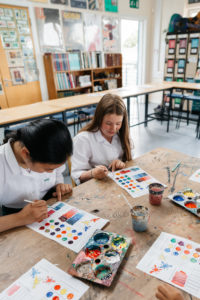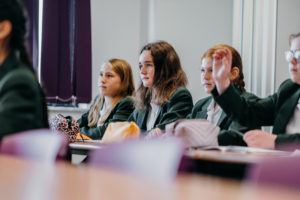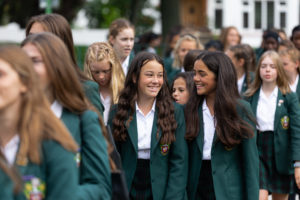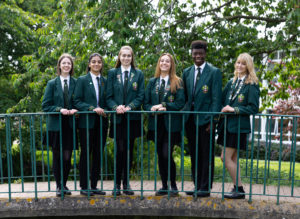A design for learning – our connected curriculum
 The curriculum intent is essentially what we ‘intend’ students to learn and is anchored in our curriculum vision statement. Each subject on the SHSG website publishes its vision statement and its intended curriculum and sequence of components and topics. Together, these subject descriptions represent the whole connected curriculum of our school.
The curriculum intent is essentially what we ‘intend’ students to learn and is anchored in our curriculum vision statement. Each subject on the SHSG website publishes its vision statement and its intended curriculum and sequence of components and topics. Together, these subject descriptions represent the whole connected curriculum of our school.
Our curriculum is ambitious and is coherently planned and sequenced towards accumulating sufficient knowledge and skills for future learning and employment.
It is, from Year 7 to Year 13, designed to give all students, including those with high needs and the most disadvantaged, the knowledge and skills they need to succeed in life.
Any remote education is integrated into the courses of study and is designed to support the wider implementation of our school’s curriculum.
Hopefully, you will find the information available in this section of the website useful in terms of understanding the content and structure of the curriculum at Southend High School for Girls. Should you require any further information, please contact Miss H Riebold, Assistant Headteacher. hriebold@shsg.org
Lower School: Years 7 – 9
 Firstly, students at SHSG follow the National Curriculum. However, as a grammar school we have planned a curriculum that goes beyond the ambitions of the National Curriculum.
Firstly, students at SHSG follow the National Curriculum. However, as a grammar school we have planned a curriculum that goes beyond the ambitions of the National Curriculum.
From Year 7, students study the separate science disciplines of physics, chemistry, and biology; they are taught by subject specialists. This places a greater demand on students and prepares them for triple science at GCSE and for studying the sciences at A Level. Within the Science Faculty, students in Lower School also study Computer Science; this is a popular subject at GCSE and A Level.
Every student completes the EBacc at the end of Middle School, Key Stage 4. Therefore, they are prepared with a comprehensive and ambitious curriculum offer in Lower School in English, mathematics, geography, history, and religious studies. In addition, from Year 7, all students study two modern foreign languages (French, Spanish, and / or German). Many students study languages at A Level.
Year 7 are taken beyond the National Curriculum in their classical studies subject (introduction to the Roman and Greek civilisation, ancient Greek, Latin, and Philosophy). Our classical studies programme is taught by a specialist classics teacher and progresses through Lower School, ready for GCSE and A Level for some students.
In addition to the EBacc and traditionally academic subjects, students in Lower School also study the full range of creative, performance and technology subjects, as well as a full PE curriculum offer. There is a strong culture of the arts and performance in school that is promoted and celebrated.
In Lower School, all students study Religious Studies, Relationships and Sex Education, and Personal, Social and Health Education. They are also guided through a taught programme on CEIAG (Careers Education, Information, Advice and Guidance), designed to prepare students for life in modern Britain by providing the knowledge, understanding, confidence and skills that they need to make informed choices and plans for their future learning and career. This is included within their Tutor Programme. The Tutor Programme is given the same value and high expectations as a timetabled lesson.
Middle School: Years 10 – 11
 Students choose their option subjects in Year 9, ready to commence their GCSE programme of study in Year 10.
Students choose their option subjects in Year 9, ready to commence their GCSE programme of study in Year 10.
In Middle School (Year 10 and 11), students complete a full range of GCSEs, and all complete the EBacc, studying at least one language, a humanity, physics, chemistry, biology, English Literature and English Language, and mathematics. In addition, two option subjects are chosen, including from technology, computing, PE, and the arts. As with Lower School, all students study Relationships and Sex Education (with consultation), and Personal, Social and Health Education. They continue with a taught programme on CEIAG.
Sixth Form: Years 12 – 13
 In the Sixth Form all students choose four A Level subjects and many complete the extended project qualification (EPQ).
In the Sixth Form all students choose four A Level subjects and many complete the extended project qualification (EPQ).
Students follow a curriculum that provides:
- Progression and stretch, building on GCSE achievements
- Work shadowing or industry placements
- Non-qualification activities such as a full tutorial programme, work to develop study, leadership and teamwork, and self-management skills.
- High-quality preparation for post 18 pathways and impartial careers guidance
The tutorial Programme is called A Level Mindset and teaches the skills of Vision, Effort, Systems, Practice and Attitude (VESPA). Sixth Form students also follow the Journey of Life programme that provides information on a range of topics from salaries, taxes and pensions to sustainable living and globalisation. Supporting this programme, a range of visiting speakers raise awareness of issues specific to our Sixth Form such as learning to drive, drugs and alcohol and responsible relationships.
Extra and super curricular programmes
The curriculum is augmented by a comprehensive range of extra and super curricular programmes. These range from Jack Petchey speaking competitions, school productions, sports teams and clubs, and a plethora of trips and visits. Super curricular opportunities build on and extend what has been taught in lessons. These include, for example, foreign exchanges, subject captains and mentoring, and subject visits and national and international competitions in maths and languages.
Sixth Form students play a significant role in supporting and organising extra and super curricular activities for their peers as well as students in lower and middle school in their leadership roles of Subject Captains.
Setting and grouping arrangements
Our teaching philosophy is that we teach to the top, pitching lessons to the highest grades. In Lower School students are taught in mixed ability classes; the population of the classes is different in different subjects, giving students an opportunity to work with a wide range of fellow students.
In Middle School (Year 10 and 11) setting is introduced in some subject areas. For example, in mathematics, the top sets study GCSE Statistics and some also complete GCSE Further Maths. Option subjects are mixed ability.
The order and sequence of topics in subjects
Every subject plans the sequence of the topics studied carefully, building on and revisiting topics throughout each stage. Parents and students can find the topics and their sequence within the subject tabs. The rationale and detail behind the topics and sequence is explained to students in lessons at the start of the course.
Table 1: curriculum model Lower School

Table 2: curriculum model Middle School

Table 3: curriculum model Sixth Form

The activities in each sixth form student’s study programme in an academic year constitute the planned hours. Each student’s planned hours are agreed between the school and the student at the start of their study programme and equate to 540+ guided learning hours. Further information on guided learning hours can be found here. Work shadowing is scheduled to the needs of the student. Some have regular work shadowing placements; others will undertake several days at a place of work.
